Urban Snake Management
Using new media for changing public attitudes and decisions related to snake encounters in Bangalore.
Studio: Facilitating Change
Assigment 3: Documentation
Student Name: Divyarajsinh Rana (205367001)
Course: Reimagining Transitions
Facilitating Change Divyarajsinh Rana (205367001) Assignment 3_Process Document
Context: Urban Wildlife Management








Public is becoming more involved in wildlife management decisions.
People's attitudes towards wildlife are shaped by their lack of knowledge, personal experiences and daily interactions with their local natural environment.
Human-Wildlife
The desirability (perceived ability to coexist with people) of a species in an urban context affects people's attitudes toward wildlife.
Wildlife is quickly adjusting and adapting to urban environments.
Narrows down from left to right

Facilitating Change Divyarajsinh Rana (205367001) Assignment 3_Process Document Overall Process of the Study
Natural Heritage Wildlife Management
Transition
Human Dimensions
Conflict
Conflict
science communication
Re-evaluating our attitudes Human-Snake
Adequate
Urban Wildlife Management
Title: Urban snake Management: Using new media for changing public attitudes and decisions related to snake encounters in Bangalore.
Keywords: Urban wildlife management, public attitudes, humansnake conflicts, new media, education, informed decisions.
Outcome: Prototype of a new media interactive toolkit related to snakes that gets activated whenever the phone senses a crawling on the ground, or a snake is spotted on the site by the general public.

Facilitating Change Divyarajsinh Rana (205367001) Assignment 3_Process Document Line of Inquiry
Overall Approach
Phase 1 of the study:
1. Primary research: Participatory learning and action (PLA) workshop 1
Understand people’s relationship and attitude to the natural environment of Jakkur lake.
i. Deploying a “do it” canvas.
ii. Pilot study to measure knowledge, attitudes, and biases of people towards wildlife.
2. Secondary qualitative research: Readings set 1
To understand the overall context of urban wildlife management and people’s attitude towards wildlife in an urban context along with understanding power and impact of new media and various digital technological approaches being taken for wildlife management in the cities.
Phase 2 of the study:
1. Primary research: Participatory learning and action (PLA) workshop 2
Understand people’s perceptions towards the snakes and identifying the core of the human-snakes conflict for strategizing the new media toolkit within the core of this issue.
i. Pilot study to clarify the types of and forming of perception towards snakes.
ii. Deploying an activity artefact related to the snakes.
2. Secondary qualitative research: Readings set 2
To understand the human-snake conflict and what forms the human perception of the snakes and looking at various cases related to new media approaches in an urban wildlife management context for strategizing and conceptualizing the new media toolkit for this study.
Phase 3 of the study:
Collating the findings of the research and using it to conceptualize the features and factors for designing the prototype of a mobile application named “SarpLok”.
Facilitating Change Divyarajsinh Rana (205367001) Assignment 3_Process Document
Phase 1 of the study: Primary research: Participatory learning and action (PLA) workshop 1
Overall intent: To understand the relationships between people and nature, how people interact with the natural environment they are part of and what does this space mean to them.

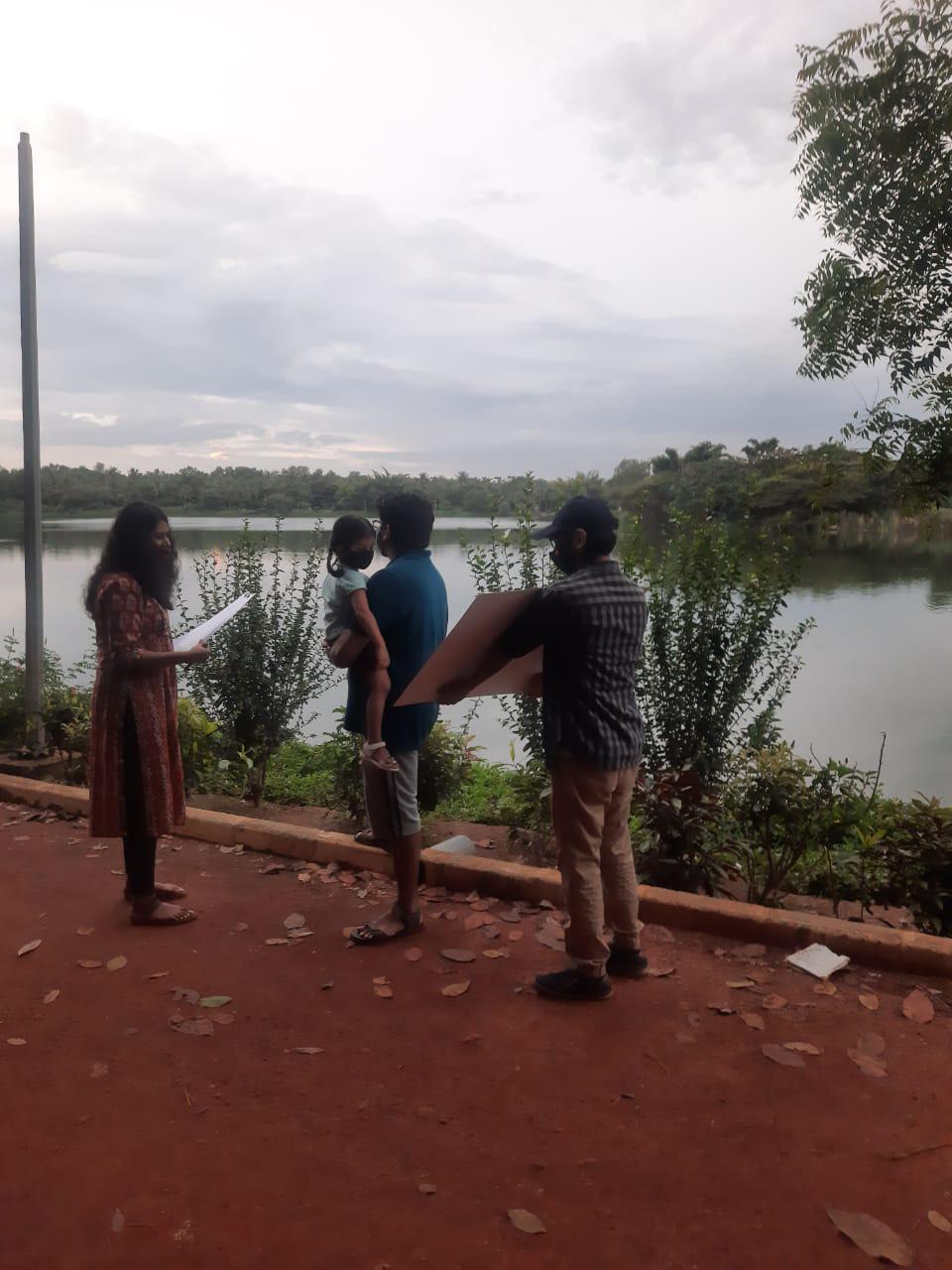
Personal intent: To understand the people’s knowledge and interests on natural heritage and to understand what the biases are and how these biases are formed.
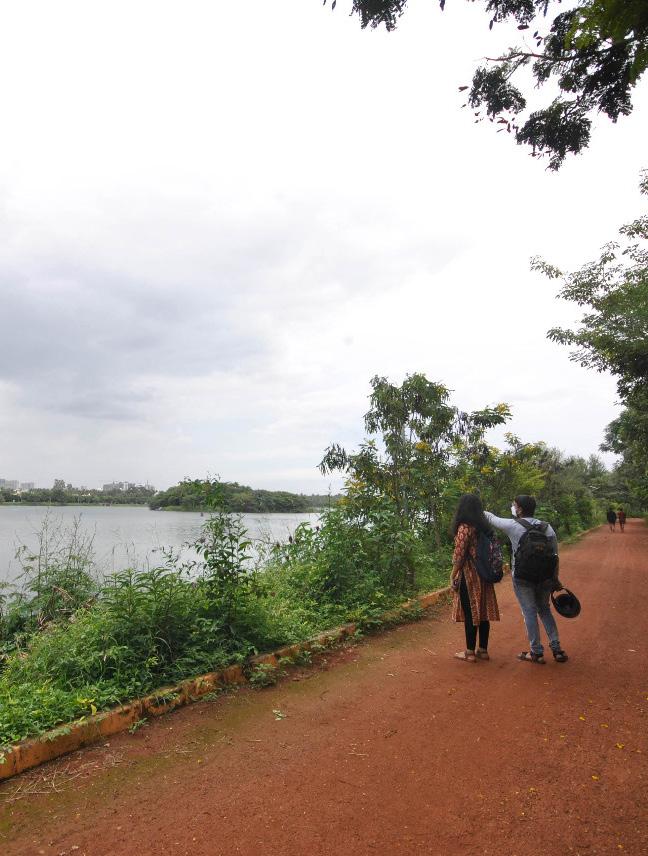
Facilitating Change Divyarajsinh Rana (205367001) Assignment 3_Process Document
Images of the PLA workshop 1 in action
Phase 1 of the study: Primary research: Participatory learning and action

(PLA) workshop 1
Activity 1: The Canvas: “do it” exhibition; People visiting the lake explained their lake to us, using words, phrases, drawing, sketch, doodle, etc.

Primary prompt:
Explain your lake to us.
Secondary prompts:
What about birds (migratory or local)?
What about snakes?
How is the lake managed?
What about fishing?
What about trees/plants?
How are you connected to the lake?
Outcomes:
1. Able to map awareness within people
2. Listen to their personal experiences related to their day-to-day interactions with nature and wildlife.
Facilitating Change Divyarajsinh Rana (205367001) Assignment 3_Process Document
The canvas curated and created at Jakkur by the people.
Infographic presenting the space of Jakkur. Source: Author.
Phase 1 of the study: Primary research: Participatory learning and action (PLA) workshop 1
Activity 2: Pilot Study: Yes/no questionnaire of 14 questions; 4 Common – 10 inquiry related questions.
Common questions
1. Do you think the climate patterns of the city have changed?
2. If somebody is damaging any part of the lake, would you intervene?
3. Do you feel bad when you see a killed snake or a dead snake?
4. Have you or are you interested in participating in any lake conservation activity?
Inquiry related questions
5. Are spot-billed Pelicans one of the common birds found at Jakkur Lake?
6. Have you ever seen this bird? Rosy Starling (Migratory Bird at Jakkur).
7. Rohu, Katla & Jalebi. Any of these fishes are found in this Lake?
8. When walking along the Jakkur Lake, do you find many known and lesser-known medicinal herbs, aromatic shrubs, as well as rare and red-listed endemic trees lining the area?
9. Does improvement in the biodiversity in the surrounding area of the lake increases the aesthetic and environmental value of the locality?
10. Can community-driven initiatives make a substanti al impact on the environment, especially when it is under threat and exploitation?
11. Do you think you should be the one taking decisions when it comes to environmental management and lake management?
12. Do you think encouraging livelihood along water bodies like fishing helps in biodiversity protection too?
13. Do you think venomous snakes like cobras, and vipers should be captured from Bangalore and released in Bannerghatta or Turahalli forest?
14. Is Jakkur lake maintenance only BBMP’s & Jalposhan’s responsibility?
Facilitating Change Divyarajsinh Rana (205367001) Assignment 3_Process Document
Phase 1 of the study: Primary research: Participatory learning and action (PLA) workshop 1
Activity 2: Pilot Study
1 Do you think the climate patterns of the city has changed?
2 If somebody is damaging any part of the lake, would you intervene? yyyyynyyyyyyyynnyyyyn
3 Do you feel bad when you see a killed snake or a dead snake? nyyyyyyyynnyyyyynyyyn
4 Have you or are you interested in participating in any lake conservation activity? ynyyyyyynyyyyyyyyyyyn
5 Arespot-billedPelicansoneofthecommon birdsfoundatJakkurLake?nnyyn
6 Haveyoueverseenthisbird?RosyStarling (MigratoryBirdatJakkur).nynn
7 Rohu,Katla&Jalebi.Anyofthesefishesare foundinthisLake?nn
8
WhenwalkingalongtheJakkurLake,doyou findmanyknownandlesser-known medicinalherbs,aromaticshrubs,aswellas rareandred-listedendemictreesliningthe area?
11
9
Doesimprovementinthebiodiversityinthe surroundingareaofthelakeincreasesthe aestheticandenvironmentalvalueofthe locality?
Cancommunity-driveninitiativesmakea substantialimpactontheenvironment, especiallywhenitisunderthreatand exploitation?
Doyouthinkyoushouldbetheonetaking decisionswhenitcomestoenvironmental managementandlakemanagement? yyyyyyyyy
12
Doyouthinkencouraginglivelihoodalong waterbodieslikefishinghelpsin biodiversityprotectiontoo? yyn
13
Doyouthinkvenomoussnakeslikecobras, andvipersshouldbecapturedfrom BangaloreandreleasedinBannerghattaor Turahalliforest?
14
IsJakkurlakemaintenanceonlyBBMP’s& Jalposhan’sresponsibility?nnynnynn
Matrix of the responses collected for pilot study. Source: Author
Facilitating Change Divyarajsinh Rana (205367001) Assignment 3_Process Document
P1P2P3P4P5P6P7P8P9P10P11P12P13P14P15P16P17P18P19P20P21P22P23P24P25
No. Question
yyyyyyyyyyyyyyyyyyyyy
ynnn
yyy
10
yyyy
ynynyny
Phase 1 of the study: Primary research: Participatory learning and action

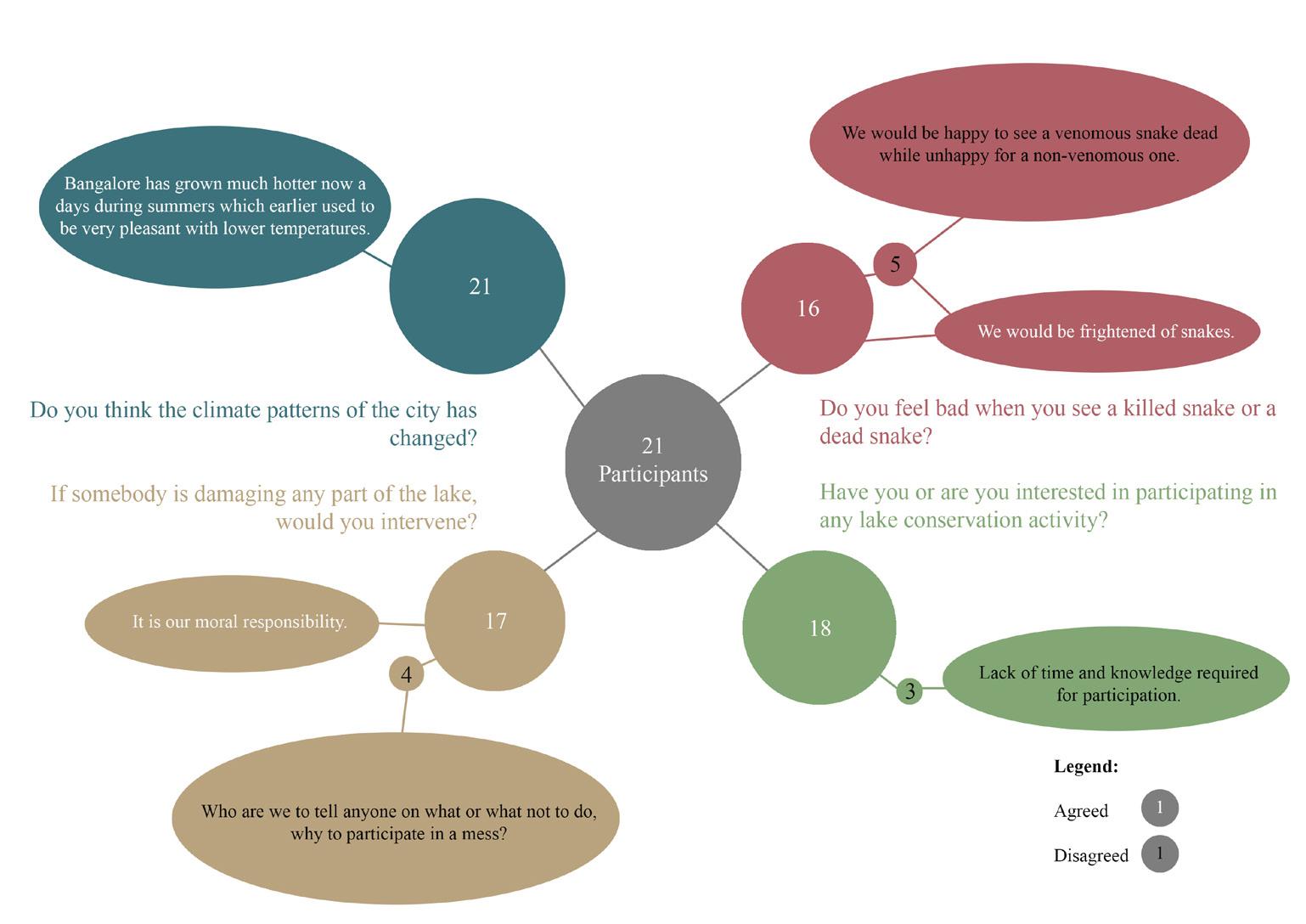
(PLA) workshop 1
Activity 2: Pilot Study
Outcome:
1. Major participants agreed to capture and relocate all the venomous snakes from the city.
2. Major participants would not feel bad to see a venomous snake dead or killed.
3. Helped to understand the biases of the people towards nature and wildlife.
4. To narrow down the line of inquiry to focus upon relationships between humans and snakes and human-snake conflicts.
5. All the participants want to be decision-makers in wildlife management, but their concerns are very personal to them and not informed scientifically.
6. There were more negative attitudes towards venomous snakes than nonvenomous ones.
Facilitating Change Divyarajsinh Rana (205367001) Assignment 3_Process Document
Infographic showing the synthesis of the first four common questions. Source: Author.
Infographic showing the synthesis of four inquiry related questions. Source: Author.
Phase 1 of the study: Secondary qualitative research: Readings set 1
1. Eeden, Lily M. van, Chris R. Dickman, Euan G. Ritchie, and Thomas M. Newsome. 2017. “Shifting Public Values and What They Mean for Increasing Democracy in Wildlife Management Decisions.” Biodiversity and Conservation 26 (11): 2759–63. https://doi.org/10.1007/s10531-017-1378-9.
2. Galle, Nadinè J., Sophie A. Nitoslawski, and Francesco Pilla. 2019. “The Internet of Nature: How Taking Nature Online Can Shape Urban Ecosystems.” Anthropocene Review 6 (3): 279–87. https://doi.org/10.1177/2053019619877103.
3. R. G. Davies, L. M. Webber, and G. S. Barnes. 2004. “Urban Wildlife Management – It’s as Much about People!” http://www.nationalparks.nsw.
4. Song, Zhifan, Qiang Wang, Zhen Miao, Kirsten Conrad, Wei Zhang, Xuehong Zhou, and Douglas C. MacMillan. 2021. “The Impact of Information on Attitudes toward Sustainable Wildlife Utilization and Management: A Survey of the Chinese Public.” Animals 11 (9): 2640. https://doi.org/10.3390/ani11092640.
5. Lunney, Daniel, and Shelley Burgin. 2004. “Urban wildlife management: an emerging discipline.” 1-7.
6. Manfredo, Michael J. “Human Dimensions of Wildlife Management.” Wildlife Society Bulletin (1973-2006) 17, no. 4, 1989: 447–49. http://www.jstor.org/ stable/3782711.
7. Bath, Alistair J. “The Role of Human Dimensions in Wildlife Resource Research in Wildlife Management.” Ursus 10, 1998: 349–55. http://www.jstor.org/ stable/3873146.
8. Decker, Daniel J., and Lisa C. Chase. “Human Dimensions of Living with Wildlife: A Management Challenge for the 21st Century.” Wildlife Society Bulletin (1973-2006) 25, no. 4, 1997: 788–95. http://www.jstor.org/stable/3783724.
9. Cinque, Serena, Johansson, Maria, and Morf, Andrea. “Book Review: Human Dimensions of Wildlife Management.” Wildlife Biology, 19(3): 335-336, 2012. https://doi.org/10.2981/0909-6396-19.3.335.
Facilitating Change Divyarajsinh Rana (205367001) Assignment 3_Process Document
Phase 2 of the study: Primary research: Participatory learning and action (PLA) workshop 2
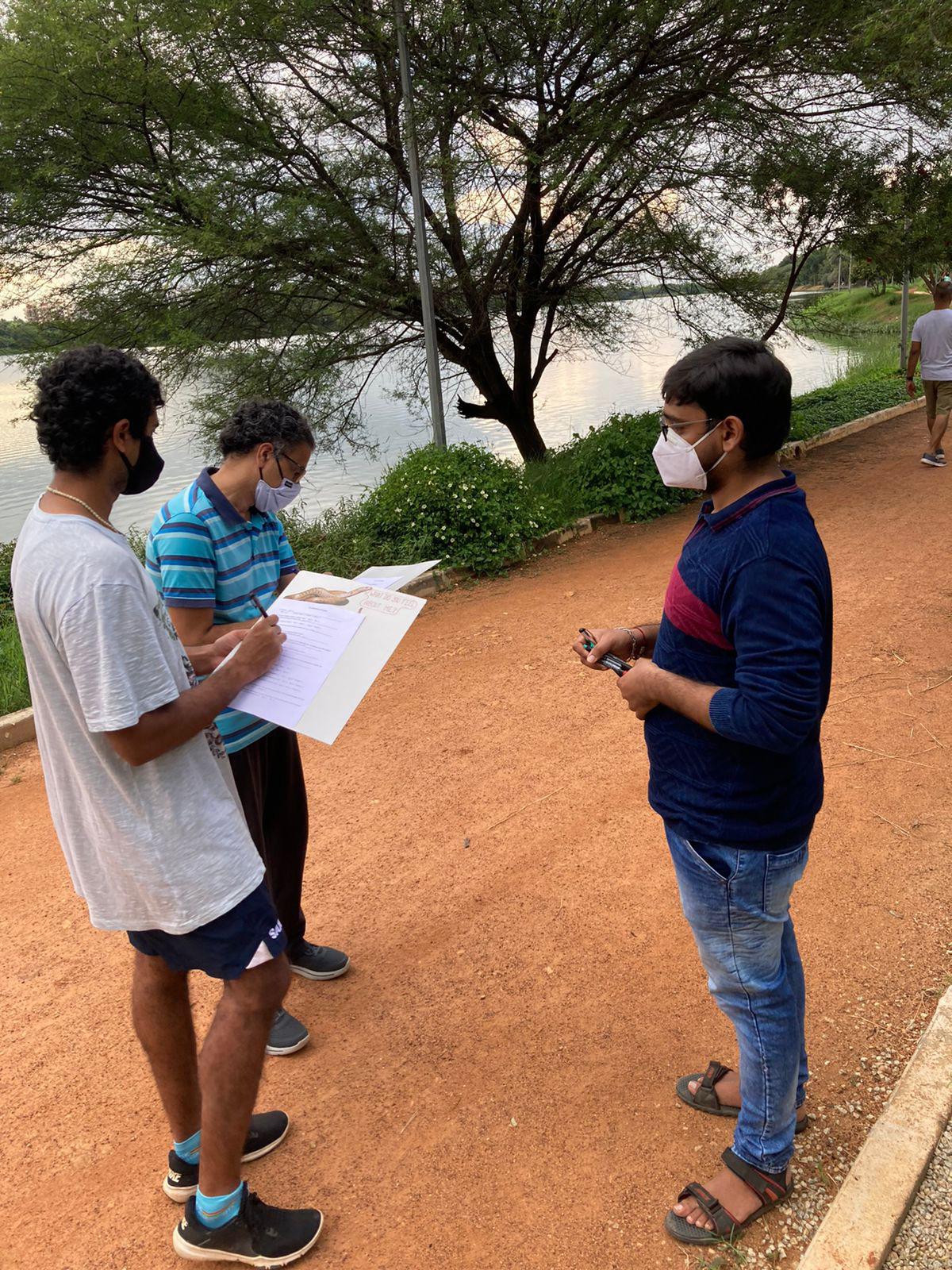
Intent: Understand people’s perceptions towards the snakes and identifying the core of the human-snakes conflict for strategizing the new media toolkit within the core of this issue.
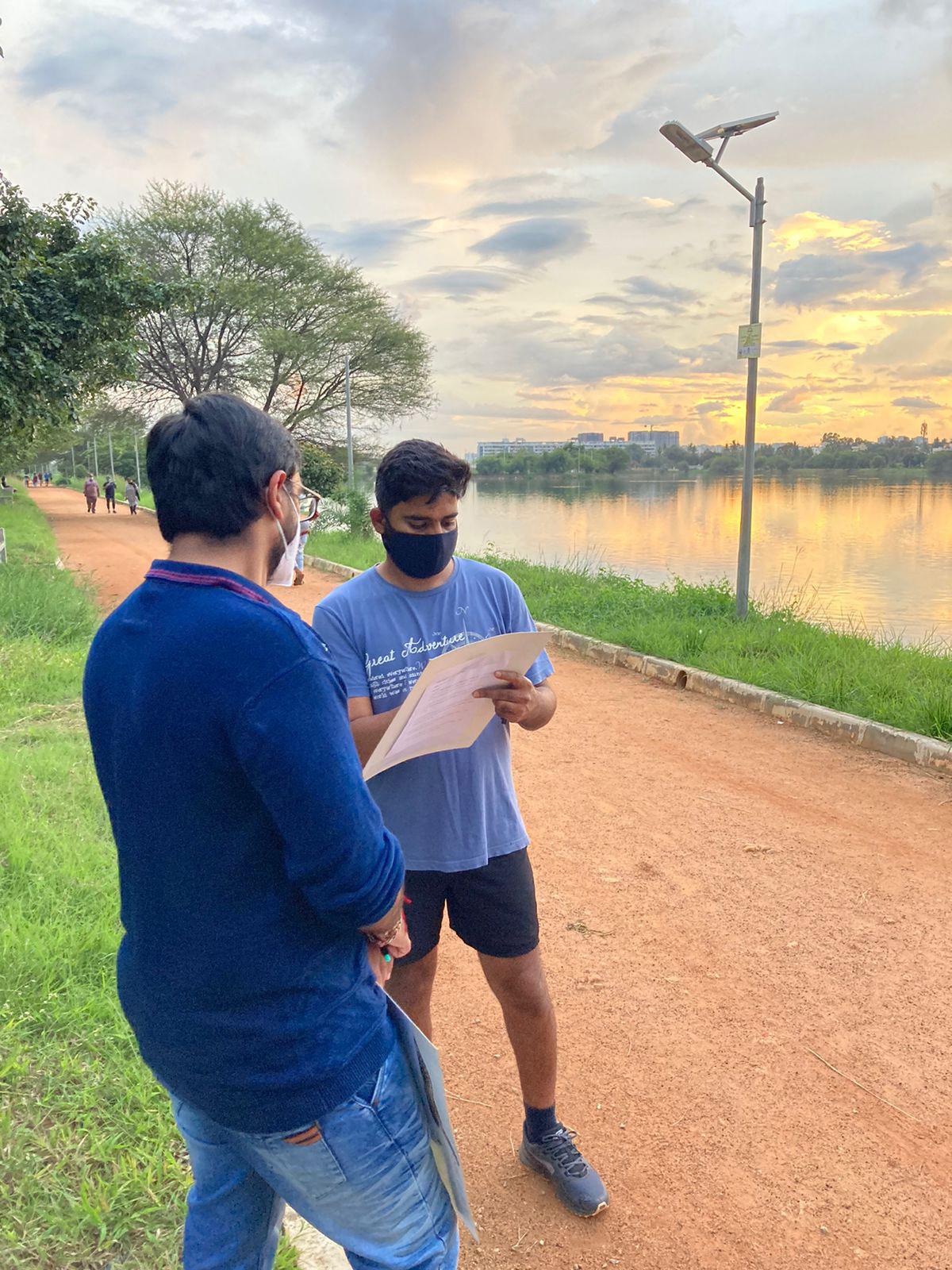

Facilitating Change Divyarajsinh Rana (205367001) Assignment 3_Process Document
Images of the PLA workshop 2 in action
Phase 2 of the study: Primary research: Participatory learning and action (PLA) workshop 2
Activity 1: Pilot Study: Questionnaire of 15 snakes related questions.
1. Name: _____________________________________________________
Age: _________ Gender: Male ( ); Female ( ); Other ( )
2. Are you a regular visitor at Jakkur Lake? Yes ( ) No ( )
Describe the purpose of your visit: ________________________________
3. Are you afraid of snakes? No ( ) Little ( ) Very ( ) Panic ( )
4. Write in a word about your feeling on when you see a snake. _________
5. Have you encountered any snakes at Jakkur Lake?
Yes ( ) Which one? (Only if you know the name): _________________ No ( )
6. Have you faced any snakes except for Jakkur Lake? (Example: At your home; any other place)
Yes ( ) Where? ______________Which snake did you see? ________ No ( )
7. Do you know what to do if you encounter a snake in Jakkur Lake?
Yes ( ) What to do? _________________________________________ No ( )
8. Do you know what to do if you find a snake that is outside of their natural habitat, a house, for example?
Yes ( ) What to do? _________________________________________ No ( )
9. Have you ever studied anything about snakes? Yes ( ) No ( )
10. Have you ever saw someone killing a snake? Yes ( ) No ( )
11. Have you or would you kill a snake if you encounter it?
Yes ( ) No ( ) Maybe ( )
12. Should venomous snakes be killed and non-venomous not?
Yes ( ) No ( ) Maybe ( )
13. Do you think that the preservation of snakes is important?
Yes ( ) No ( ) Maybe ( )
14. Do you think that all venomous snakes from the city including Jakkur Lake should be captured and relocated to a forest?
Yes ( ) No ( ) Maybe ( )
15. Do you think a mobile application providing you with the relevant information when you encounter a snake would help you to take better decisions?
Yes ( ) No ( )
Facilitating Change Divyarajsinh Rana (205367001) Assignment 3_Process Document
Phase 2 of the study: Primary research: Participatory learning and action (PLA) workshop 2
Activity 1: Pilot Study
No. Question P1P2P3P4P5P6P7P8P9P10P11 MFMMFFMMFMM 3834323031435725193754
1Are you a regular visitor at Jakkur Lake? ynyyyyyynyy
2 Are you afraid of snakes? NoLittleLittleLittleNoVeryVeryVeryPanicVeryLittle
3 Write in a word about your feeling on when you see a snake. NiceScaryNumbScaryNuetralScaryDangerFearFaintCautiousFear
4 Have you encountered any snakes at Jakkur Lake? ynnnnnynnyy
5 Have you faced any snakes except for Jakkur Lake? (Example: At your home; any other place) yyyyyyyyyyy
6 Do you know what to do if you encounter a snake in Jakkur Lake? yyynnyynyny
7 Do you know what to do if you find a snake that is outside of their natural habitat, a house, for example? yyyyyyynnyy
8 Have you ever studied anything about snakes? nnnnyynyyyy
9 Have you ever saw someone killing a snake? nynnynyyyny
10 Have you or would you kill a snake if you encounter it? nnnnmbnnnnnn
11 Should venomous snakes be killed and non-venomous not? nnnnmbnnnnnn
12 Do you think that the preservation of snakes is important? yyyyyyyyyyy
13 Do you think that all venomous snakes from the city including Jakkur Lake should be captured and relocated to a forest? nnyymbnmbynmby
14 Do you think a mobile application providing you with the relevant information when you encounter a snake would help you to take better decisions? yyyyyyyyyyy
Matrix of the responses collected for pilot study. Source: Author
Facilitating Change Divyarajsinh Rana (205367001) Assignment 3_Process Document
Age Gender
Primary
Phase 2 of the study: Primary research: Participatory learning and action (PLA)
workshop 2
Activity 1: Pilot Study
Research: PLA Workshop 2: Activity 1
Outcome:
• 7Male,4female,0otherparticipants.
• 9ofthemwereregularvisitorsand2werenot.
Outcome:
Questions:
1. Most of the participants used the words scary and fear to describe a snake.
1.Areyouafraidofsnakes?No()Little()Very()Panic()
2.Writeinawordaboutyourfeelingonwhenyouseeasnake.
2. All the participants have seen a snake outside their natural environments.
3. Participants who have studied snakes were comparatively lesser scared of snakes.
4. All the participants agreed on having a mobile application toolkit for snake encounters would be helpful.
PLA Workshop 2: Activity 1
5. An almost equal number of participants said yes-no-maybe on the relocation of venomous snakes from city to forest.
No / Nuetral & Nice Little/ Danger & Cautious Very/ Scary & Fear Panic/ Numb & Faint
Primary Research: PLA Workshop 2: Activity 1
Outcome:
1.Have you encountered any snakes at Jakkur Lake?
2.Have you faced any snakes except for Jakkur Lake? (Example: At your home; any other place)
3.Do you know what to do if you encounter a snake in Jakkur Lake?
4.Do you know what to do if you find a snake that is outside of their natural habitat, a house, for example?
5.Have you ever studied anything about snakes?
6.Have you ever saw someone killing a snake?
Question 11Question 12Question 13Question 14
7.Do you think a mobile application providing you with the relevant information when you encounter a snake would help you to take better decisions?
Yes No Maybe
Graphs summarizing the responses to the questions of pilot study
Question 5Question 6Question 7Question 8Question 9Question 10Question 15
Yes No
Graphs summarizing the responses to the questions of pilot study
Facilitating Change Divyarajsinh Rana (205367001) Assignment 3_Process Document
0 1 2 3 4 5 6 7 8 9 10 11
Question 3
Question 4
0 1 2 3 4 5 6 7 8 9 10 11
0 1 2 3 4 5 6 7 8 9 10 11
encounter it? non-venomous not? important? city including a forest?
Graphs summarizing the responses to the questions of pilot study
Phase 2 of the study: Primary research: Participatory learning and action (PLA)
workshop 2
Activity 2: Activity artefact on snakes


Outcome:
1. For most of the participants, the feelings towards snakes did not change after providing them with facts on the snake.
2. A lot of participants avoided reading about the snakes due to lack of time.
3. The culture of the participants affected the perception of the snake as for some it was a symbol of worshipping.
The artefacts curated and created on snakes at Jakkur by the people.
Facilitating Change Divyarajsinh Rana (205367001) Assignment 3_Process Document
Phase 2 of the study: Secondary qualitative research: Readings set 2
1. Pinheiro, Luan Tavares, João Fabrício Mota Rodrigues, and Diva Maria Borges-Nojosa. 2016. “Formal education, previous interaction and perception influence the attitudes of people toward the conservation of snakes in a large urban center of northeastern Brazil.” Journal of Ethnobiology and Ethnomedicine. https://doi. org/10.1186/s13002-016-0096-9.
2. Baynes-Rock M. 2017. “Human Perceptual and Phobic Biases for Snakes: A Review of the Experimental Evidence”. Anthrozoos. 30 (1): 5-18.
3. Landová, Eva, Jana Marešová, Olga Šimková, Veronika Cikánová, and Daniel Frynta. 2012. “Human responses to live snakes and their photographs: Evaluation of beauty and fear of the king snakes”. Journal of Environmental Psychology. 32 (1): 69-77.
4. Bateman, Heather L., Jeffrey A. Brown, Kelli L. Larson, Riley Andrade, and Bryan Hughes. 2021. “Unwanted residential wildlife: Evaluating social-ecological patterns for snake removals”. Global Ecology and Conservation. 27: e01601.
5. Büscher, B.E. 2016. “Nature 2.0: Exploring and theorizing the links between new media and nature conservation”. New Media & Society. 18 (5): 726-743.
6. Broaden, Courtney G. 2002. “Enhancing wildlife agency effectiveness through Internet communications.”
Facilitating Change Divyarajsinh Rana (205367001) Assignment 3_Process Document
Phase 2 of the study: Secondary qualitative research: Readings set 2
1. Pinheiro, Luan Tavares, João Fabrício Mota Rodrigues, and Diva Maria Borges-Nojosa. 2016. “Formal education, previous interaction and perception influence the attitudes of people toward the conservation of snakes in a large urban center of northeastern Brazil.” Journal of Ethnobiology and Ethnomedicine. https://doi. org/10.1186/s13002-016-0096-9.
2. Baynes-Rock M. 2017. “Human Perceptual and Phobic Biases for Snakes: A Review of the Experimental Evidence”. Anthrozoos. 30 (1): 5-18.
3. Landová, Eva, Jana Marešová, Olga Šimková, Veronika Cikánová, and Daniel Frynta. 2012. “Human responses to live snakes and their photographs: Evaluation of beauty and fear of the king snakes”. Journal of Environmental Psychology. 32 (1): 69-77.
4. Bateman, Heather L., Jeffrey A. Brown, Kelli L. Larson, Riley Andrade, and Bryan Hughes. 2021. “Unwanted residential wildlife: Evaluating social-ecological patterns for snake removals”. Global Ecology and Conservation. 27: e01601.
5. Büscher, B.E. 2016. “Nature 2.0: Exploring and theorizing the links between new media and nature conservation”. New Media & Society. 18 (5): 726-743.
6. Broaden, Courtney G. 2002. “Enhancing wildlife agency effectiveness through Internet communications.”
Facilitating Change Divyarajsinh Rana (205367001) Assignment 3_Process Document
“We, creatures of the city, are so removed from the wilderness that we have no idea of animal behaviour, let alone animal physiognomy.”
-C. K. Meena
Cities aren’t known for their wild animals or natural environments, yet they do make up 36 of the world’s biodiversity hotspots (Galle, Nitoslawski, and Pilla 2019). Today, it is clear that wildlife is quickly adjusting and adapting to urban environments. Despite how contradictory the phrase “urban wildlife” sounds, it serves as a vital link to the natural world for both present and future generations of urban dwellers. However, since not all organisms adapt to urbanisation in the same way, there is a risk of natural biodiversity and ecological integrity being lost. Urban wildlife management can thus be defined as the management of natural creatures living in natural habitats located in urban settings, rejecting the assumption that nature conservation only takes place outside of the city. However, when it comes to urban wildlife, which species should be considered? What methods can be used to identify and manage wildlife in urban areas? How do you tell the species apart and figure out what they need in terms of habitat? are only a few of the unanswered questions. Today, societal views toward nature are evolving from human dominance to a sort of mutualism in which animals are treated equally as humans. As a result, the public is becoming more involved in wildlife management decisions, and
scientists and wildlife managers can no longer ignore public values (van Eeden et al. 2017). But the problem lies at the point where people’s attitudes about wildlife and concerns on natural heritage conservation are shaped by their daily interactions with their local natural environment. The desirability (perceived ability to coexist with people; desirable, desired but inappropriate, undesirable) of a species in an urban context affects people’s attitudes toward wildlife (Davies, R. G., Webber, L. M., and Barnes, G. S. 2004). Snakes and especially the venomous snakes fall under the category of undesirable species thus leading to increasing humansnake conflicts in an urban context. There is a need to re-evaluate our attitudes toward wildlife in the city, and it is now necessary to assess the ethics and values that shape our decisions and, as a result, our wildlife management actions. Thus, with increased public participation in wildlife management decision-making processes, wildlife conservationists should optimize the information dissemination environment to communicate the complex scientific nature of conservation issues (Song et al. 2021). Adequate science communication about wildlife conservation and management can foster a scientific conservation attitude toward wildlife among the general public, resulting in informed behavioural changes that can have a greater impact on animal conservation efforts in a city. This inquiry is also aimed at developing a toolkit for changing human biases about the snakes and especially for venomous snakes and how to interact and manage our encounters with these shared neighbours. People need to know about the scientific values of both venomous and non-venomous snakes for them to take an informed decision on their sudden encounters with snakes in an urban environment. This study
Facilitating Change Divyarajsinh Rana (205367001) Assignment 3_Process Document Summarized Literature Review
has the potential to change the nature of snake management in the long run by influencing community attitudes about snakes to be more positive rather than negative.
As cities become more digital, there is a growing need to digitally transform the natural capital of cities. New media, particularly social media, has shown to be a powerful tool for distributing and mass communicating information on any subject. Thus, conservation scientists can use new media platforms to convey their findings in a way that is both accessible and appealing to the general public, resulting in a change in public perceptions towards urban wildlife. (Song et al. 2021). However, as appealing as this may appear, public information being disseminated through new media must be thoroughly authenticated or scientifically verified, as disinformation can lead to more misconceptions, escalating humanwildlife conflicts in an urban context. One example of such digital technology is the Internet of Nature (IoN), it depicts urban ecosystems and is subsequently used to inform management and planning decisions. IoN is used for monitoring and managing urban nature, for ecosystem functioning and resilience and for linking social and ecological systems within the city. The goal of this technology is to strengthen human-nature relationships in our constantly evolving and changing urban surroundings (Galle, Nitoslawski, and Pilla 2019). This inquiry looks at new media as a tool for dissemination of snake management toolkit for communicating the scientific information related to snakes thus improving and changing people’s ability to manage their encounters with snakes in an urban context.
Facilitating Change Divyarajsinh Rana (205367001) Assignment 3_Process Document
1. Most of the participants were fearful of the snakes, fear and scary were the common words used by them to describe their feelings about snakes.
2. Most of the participants had their biases towards venomous snakes, but the equal were the numbers with a maybe.
3. The attitudes and perceptions of people toward snakes are influenced by sociodemographic factors, such as formal education and gender, and by personal experience.
4. Prior interaction and education about snakes decreased the occurrence of negative perceptions and reduced the level of human fear of these animals.
5. Culture also influences the perception about the snakes. As for some participants snake was a symbol of worship.
Facilitating Change Divyarajsinh Rana (205367001) Assignment 3_Process Document
Overall findings of the study






















